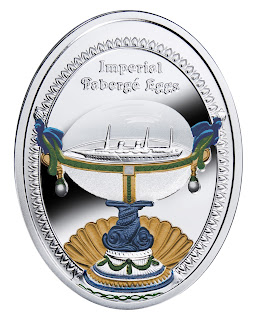Niue 1 Dollar Silver Coin 2015 Standart Yacht Egg - Faberge Eggs
Series: Imperial Fabergé Eggs
Obverse: At the bottom – open „Spring Flowers Egg” (1899-1903) with a miniature basket and a bouquet of anemones. Above the basket – the effigy of Her Majesty Queen Elizabeth II with an inscription: ELIZABETH II and the mint mark (m/w). Around – a decorative, neo-rococo ornament. Along the rim – the issuer’s name: NIUE ISLAND, the face value: 1 DOLLAR, the hallmark (Ag 999) and the year of issue – 2015.
Reverse: Features a miniature replica of the "Standard Yacht", the largest imperial yacht afloat. The jewel is a transparent rock crystal egg, mounted horizontally and decorated with a diamond-studded Gold band with inlaid leaves of green enamel. Both sides of the egg are surmounted with two lapis lazuli eagles, each decorated with white pearls. The masterpiece of jewelry art is additionally supported by two lapis lazuli dolphins placed on an ornate stand.
Country: Niue Island.
Year of Issue: 2015.
Metal: Silver.
Silver Fineness: Ag 999/1000.
Content: 0.54 Troy OZ.
Denomination: 1 NZD - legal tender in New Zealand.
Weight: 16.81 g.
Diameter: Ellipse 39 x 29.20 mm.
Quality: Proof.
Mintage: 9,000.
Exterior Decoration: Zircons and Elements in Polished Finish.
Producer: Mint of Poland (Mennica Polska).
Series: Imperial Fabergé Eggs
Standart Yacht Egg 1909 Faberge Bouquet of Lilies Clock Egg 1899 Faberge
Standart Yacht Egg - Faberge Eggs
The Standart Yacht Egg is a jewelled Easter egg made under the supervision of the Russian jeweller Peter Carl Fabergé in 1909 for Tsar Nicholas II of Russia. It was presented by Nicolas II as an Easter gift to his wife, the Czarina Alexandra Fyodorovna. It is currently held in the Kremlin Armoury Museum in Moscow, and it is one of the few Fabergé eggs that have never left Russia.
Design
The Standart Yacht Leaf Egg is a transparent hollowed-out rock crystal egg, mounted horizontally, with a gold band with inlaid leaves of green enamel and small diamonds marking the separation point between upper and lower halves, which bears the inscription "Standart 1909". A crowned lapis lazuli eagle is perched on either side of the egg and a large pear-shaped pearl hangs from each. The shaft consists of two lapis lazuli dolphins with intertwined tails. It is on an ornate stand with classical overtones, made from gold, pearls, and enamel.
Surprise
The surprise is a golden replica of the Imperial Yacht, the Standart Yacht, made of gold and platinum, and coated in vitreous enamel. The model rests on a carved bed of crystal representing the ocean, but can be removed from the egg.
History
The c5,500 ton Standart was commissioned by Tsar Alexander III in Copenhagen. It was launched in 1895 and was 116 meters long, which made it the largest yacht in the world at that time. Outfitted with ornate fixtures, including mahogany paneling, crystal chandeliers, and other amenities (including a stable with a cow to provide the imperial children with fresh milk) it was a floating palace for the Russian Imperial Family for their vacations in the Baltic Sea. The Russian Imperial Family was vacationing on the Standart during the summer of 1914, when they received the news of the assassination of Archduke Franz Ferdinand, in Sarajevo, marking the start of World War I.
Russian yacht Standart
The Standart, was an Imperial Russian yacht serving Emperor Nicholas II and his family, was in her time (late 19th/early 20th century) the largest Imperial Yacht afloat. After the Russian Revolution the ship was placed in drydock until 1936, when she was converted to a minelayer. During World War II she played a significant role in the defence of Leningrad.
Imperial Yacht
The Imperial Yacht Standart (Штандартъ) was built by order of Emperor Alexander III of Russia, and constructed at the Danish shipyard of Burmeister & Wain, beginning in 1893. She was launched on 21 March 1895 and came into service early September 1896.
Standart was fitted out with ornate fixtures, including mahogany paneling, crystal chandeliers, and other amenities that made the vessel a suitable floating palace for the Russian Imperial Family. The ship was manned and operated by a crew from the Russian Imperial Navy. During the reign of Nicholas II, Standart was commanded by a naval Captain, although the official commander was a Rear Admiral. Her commander in 1914 was Nikolai Pavlovich Sablin.
In 1907, Standart ran aground on an uncharted rock off the Finnish coast. Although damaged, the ship did not sink and was repaired and soon returned to service. The Russian Imperial Family was vacationing on the Standart during the summer of 1914, when they received the news of the assassination of Archduke Franz Ferdinand, in Sarajevo. With the outbreak of World War I, Standart was placed in drydock.
Soviet Minelayer Marti
After the fall of the Romanov Dynasty, Standart was stripped down and pressed into naval service. The ship was renamed 18 marta (18 March), and later Marti. In 1932-1936, Marti was converted into a minelayer by the Marti yard in Leningrad. During the Second World War, Marti served in the Baltic, laying mines and bombarding shore positions along the coast. On 23 September 1941, Marti was damaged in an air attack at Kronstadt, but later repaired and continued service until the end of the war.
After the war, Marti was converted into a training ship and renamed Oka in 1957. She continued serving in that role until she was scrapped at Tallinn, Estonia, in 1963.

